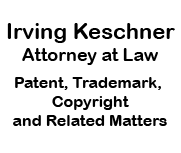| Relationship Between Patents, Trademarks and Copyrights | ||||
|---|---|---|---|---|
| Proprietary Right | Utility Patent | Design Patent | Trademark or Service Mark | Copyright |
| What is Protected | Functional features of a process, machine, article of manufacture, or composition of matter. | Aesthetic features of a manufactured article | Words, names, or symbols | Writing, computer, software, music, works of art. |
| Requirements | Novel and unobvious | Novel and unobvious | Used to distinguish one person's goods or services from those of others. | Originality |
| How rights are acquired | Only granted by federal government | Only granted by federal government | Common Law: adoption and use. State Registration: adoption, use and application Federal Registration: adoption, use or intention to use, and application. |
Automatically acquired when created; early registration is recommended to preserve statutory damage rights |
| Term of Protection | 20 years from filing | 14 years from issuance | Common Law: as long as used as a mark. Federal Registration: 10 years with right to renew for 10 year terms in perpetuity, so long as properly used. |
If owned by a natural person: the life of the author + 50 years. If the work is an anonymous, pseudonymous work, or a work made for hire: 75 years from the first publication, or 100 years from creation, whichever expires first. |
| Infringement | Making, using or selling in the U.S. a device coming within the scope of any patent claim | Making, using or selling in the U.S. a product that looks substantially similar (to the eye of an ordinary observer). | Using a mark that causes likelihood of confusion as to source or sponsorship | Copying, resulting in substantial similarity. |
